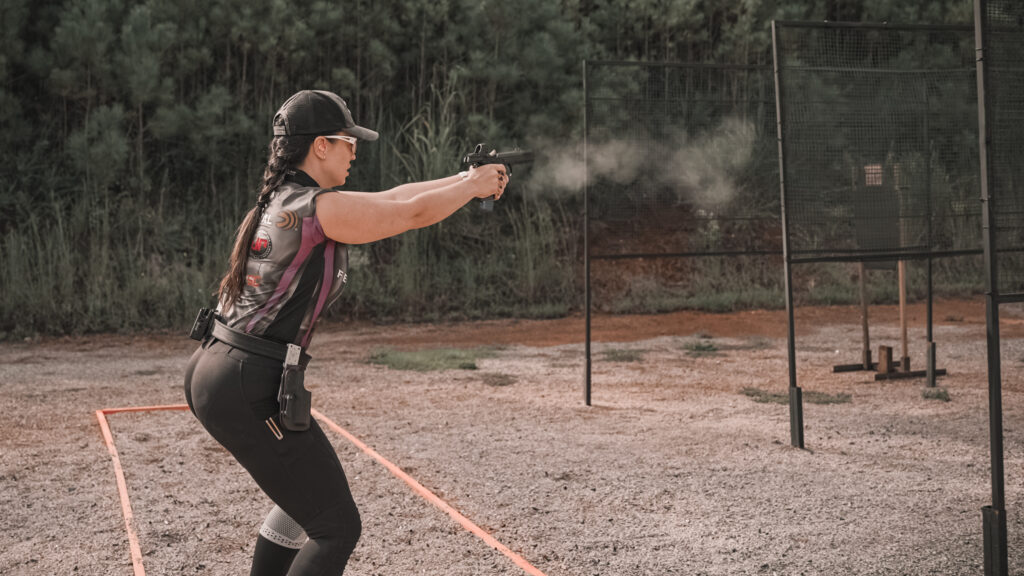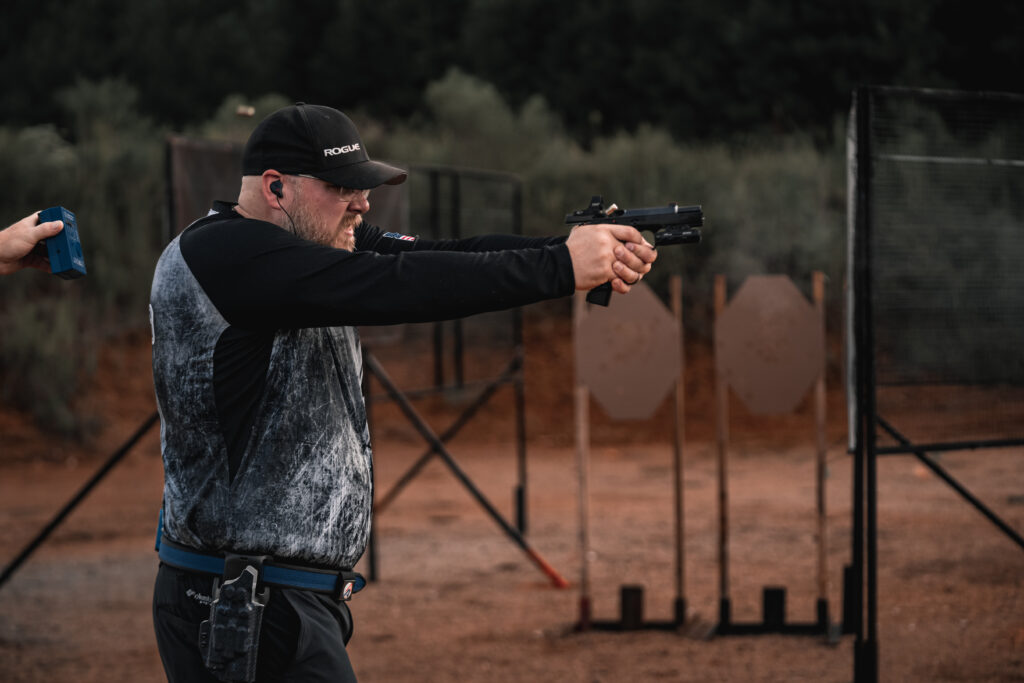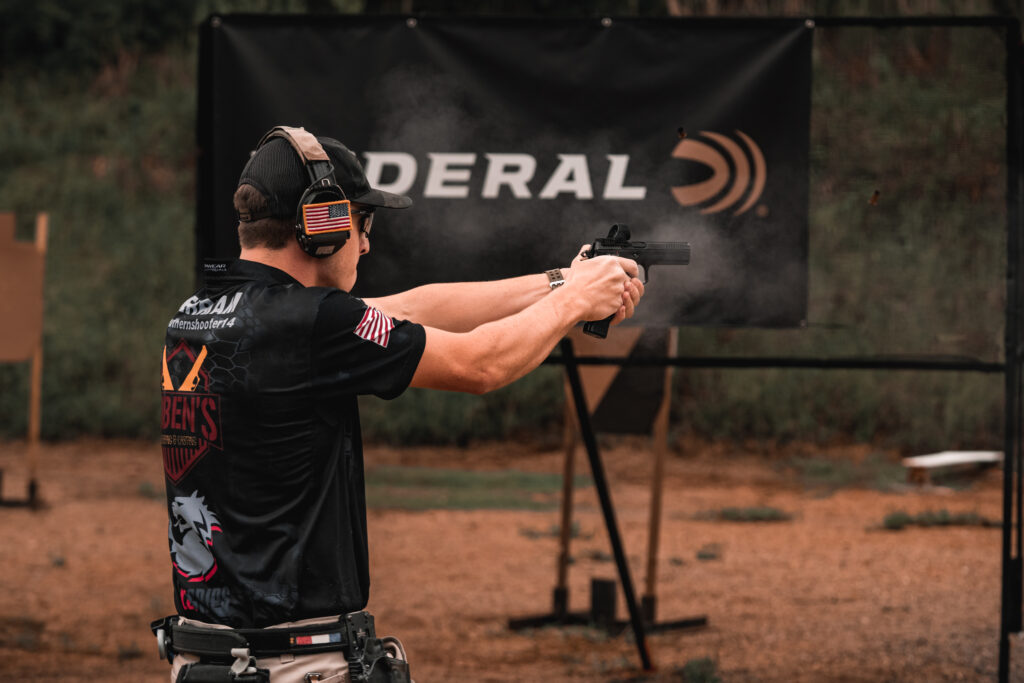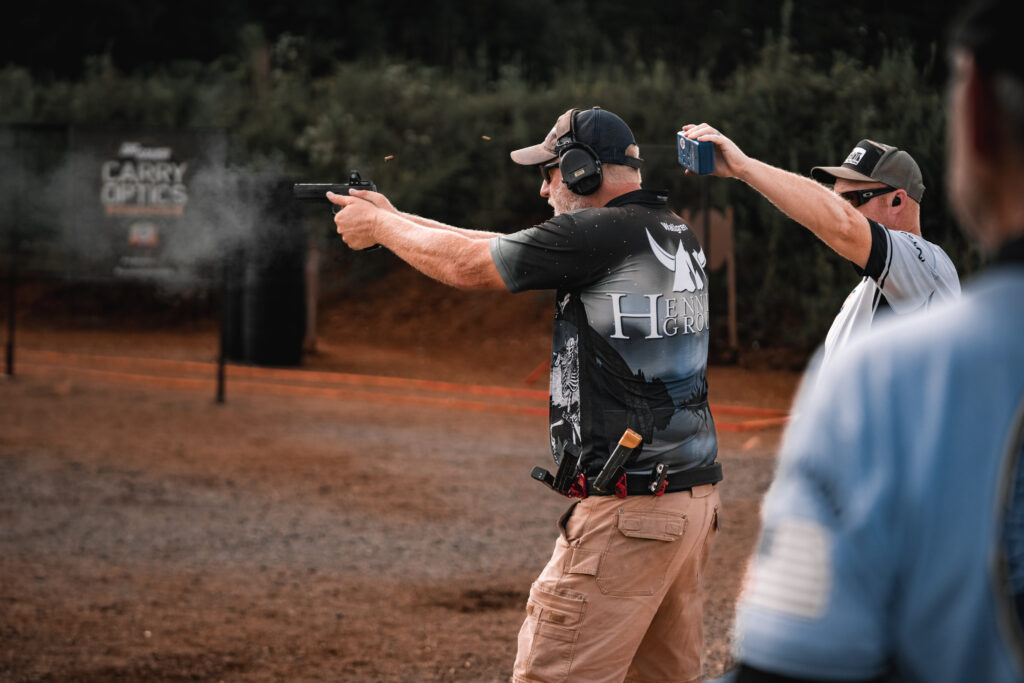
In practical shooting competitions, marksmanship and strategy are key to success. The hit factor scoring system has become popular. It’s vital for those aiming to excel in the United States Practical Shooting Association (USPSA) and other practical shooting events.
Hit factor scoring evaluates performance by combining accuracy and speed. It calculates points earned per second, considering both the time to complete a stage and shot accuracy. This system rewards those who balance precision with speed, making it a true test of marksmanship skills.
In practical shooting, where quick decisions and precise actions are critical, hit factor scoring is the standard. Competitors aim for the highest hit factor score. This pushes them to refine their marksmanship skills, challenge their limits, and adopt tactical strategies to enhance their performance.

In practical shooting, hit factor scoring is vital for assessing performance. It’s a scoring system that considers both speed and accuracy. This provides a quantifiable measure of a shooter’s skill.
Hit factor scoring is mainly used in USPSA (United States Practical Shooting Association) matches. It allows participants to showcase their marksmanship while under time pressure.
So, how does hit factor scoring work? Let’s break it down:
Hit factor scoring evaluates a shooter’s performance by calculating a score based on time and accuracy.
The hit factor score is found by dividing points scored by the time to complete the course. Points are based on shot accuracy, while time reflects the shooter’s speed.
The purpose of hit factor scoring is to measure a shooter’s ability to balance speed and accuracy. It highlights the importance of achieving accurate hits quickly. This tests the shooter’s decision-making and ability to perform under pressure.
Here is an example of how hit factor scoring works:
| Stage | Points | Time | Hit Factor |
|---|---|---|---|
| 1 | 95 | 11.50 seconds | 8.26 |
| 2 | 108 | 12.75 seconds | 8.47 |
| 3 | 85 | 10.00 seconds | 8.50 |
In this example, the shooter’s total score is the sum of each stage’s hit factor. The higher the hit factor, the better the shooter’s performance.
Understanding hit factor scoring is key for any shooter aiming to excel in practical shooting competitions. It pushes shooters to find a balance between speed and accuracy. This improves their marksmanship skills while maintaining efficiency in completing stages. Next, we’ll explore the importance of hit factor scoring in practical shooting.

In practical shooting, hit factor scoring is key to evaluating a shooter’s marksmanship. It measures both speed and accuracy, pushing participants to excel in their shooting. This scoring system offers a complete view of a shooter’s performance.
Hit factor scoring motivates shooters to balance speed and precision. A high score means quick and accurate shots. It’s about being fast and precise at the same time.
This scoring method is different from traditional systems. It rewards quick completion of stages with high accuracy. This makes competitions challenging, driving shooters to improve their skills.
To understand hit factor scoring better, let’s look at an example:
| Shooter | Total Points | Total Time (seconds) | Hit Factor Score |
|---|---|---|---|
| John | 95 | 20 | 4.75 |
| Sarah | 98 | 25 | 3.92 |
In this example, John and Sarah scored similar points but had different hit factor scores. John’s score was higher because he was faster and accurate. This shows how hit factor scoring values both speed and accuracy.
Improving hit factor scores helps shooters develop important skills. These include quick target acquisition, efficient movement, and fast decision-making. These skills are useful in competitions and real-life situations.
The United States Practical Shooting Association (USPSA) is the top organization for practical shooting in the U.S. Founded in 1984, USPSA has led in organizing hit factor scoring competitions. It focuses on real-world shooting scenarios, combining speed, accuracy, and strategy to find the best shooter.
USPSA aims to grow and promote practical shooting. It offers a place for shooters of all levels to compete and get better. With various match formats, shooters can show their skills at regional, national, and international levels.
USPSA’s hit factor scoring has changed how marksmanship is judged in competitions. This approach has made practical shooting more competitive and inspired shooters to improve.
As the leading authority, USPSA sets standards and rules for the sport. Its officials ensure fair and safe matches, highlighting each participant’s skills.

In practical shooting sports, achieving high hit factor scores requires speed, accuracy, and a grasp of marksmanship fundamentals. To excel in hit factor scoring competitions, shooters must focus on the key elements that contribute to precise and controlled shooting.
Grip: A proper grip is essential for maintaining control and stability while shooting. Shooters should ensure a firm and consistent grip, with the support hand assisting in controlling recoil. This allows for quick follow-up shots and improved accuracy.
Stance: The right shooting stance provides a stable platform and minimizes body movement during firing. Shooters should adopt a squared-off stance with the feet shoulder-width apart, distributing their weight evenly. This aids in recoil management and facilitates faster target transitions.
Sight Alignment: Achieving proper sight alignment is critical for accurate shooting. Shooters should focus on aligning the front and rear sights to form a clear and centered sight picture. This ensures precise aiming and helps maintain consistency across multiple shots.
Trigger Control: Maintaining proper trigger control is essential for precise shot placement. Shooters should develop a smooth and deliberate trigger press, avoiding any jerking or anticipation that may lead to less accurate shots. A controlled trigger squeeze ensures minimal disruption to sight alignment, resulting in improved marksmanship.
By mastering these fundamental aspects of marksmanship, shooters can enhance their performance in hit factor scoring competitions. The ability to consistently apply these techniques under pressure is key to achieving higher scores and competing at an elite level. Practice and repetition are essential in developing muscle memory and fine-tuning these skills.
Continuously refining one’s marksmanship abilities through targeted training and practice drills is vital for success in hit factor scoring competitions. The next section will explore strategies that can further maximize hit factor scores, providing valuable insights for practical shooting enthusiasts.
When it comes to practical shooting competitions, shooters are always looking for ways to increase their hit factor scores. By employing effective strategies and tactics, competitors can improve their overall performance and achieve higher scores. Here, we will explore some key strategies that can help shooters maximize their hit factor scores.
One of the most critical aspects of practical shooting is stage planning. Before stepping onto the stage, take the time to carefully analyze and strategize your approach. Identify the optimal shooting positions, target sequences, and movement patterns that will allow you to complete the stage with speed and precision. By having a well-thought-out plan, you can avoid unnecessary movement and make the most of each shot.
In practical shooting, movement plays a vital role in achieving higher hit factor scores. Efficient movement between shooting positions can save precious seconds and allow for quicker engagement of targets. Focus on smooth transitions, maintaining balance, and minimizing unnecessary steps. Practice your movement techniques to ensure fluidity and accuracy while on the move.
Developing effective target engagement strategies can significantly impact your hit factor scores. Consider the order in which you engage targets, aiming for the most high-value targets first. Prioritize difficult shots or targets that require longer transition times, ensuring that you leave enough time for accurate hits. Adjust your shooting pace according to each target, maintaining a balance between speed and accuracy.
Here’s an illustrative example of how target engagement strategies can influence hit factor scores:
| Shooter | Stage Time | Total Points | Hit Factor |
|---|---|---|---|
| Shooter A | 20 seconds | 120 points | 6.00 |
| Shooter B | 18 seconds | 110 points | 6.11 |
In the example above, despite Shooter B having a slightly lower total point score, their faster stage time results in a higher hit factor. This demonstrates the importance of implementing effective target engagement strategies to maximize scoring.
By incorporating these strategies into your training and competition routines, you can enhance your hit factor scores and improve your overall performance in practical shooting. Remember, efficient stage planning, movement, and target engagement are key elements in achieving success. Practice these strategies consistently, and you’ll see your hit factor scores soar.

Understanding hit factor scoring in practical shooting is best done through real-life examples. By looking at different scenarios, we gain insights into improving scores and refining our techniques. Let’s examine some practical shooting examples and the strategies used to boost hit factor scores.
Shooter A finished a stage quickly, while shooter B focused on precision. Let’s compare their hit factor scores:
| Shooter | Time | Total Points | Hit Factor Score |
|---|---|---|---|
| Shooter A | 19.64 seconds | 120 | 6.11 |
| Shooter B | 22.98 seconds | 150 | 6.52 |
Shooter B got a higher hit factor score, even though they took more time. This shows the need for balance between speed and accuracy to improve scores.
Split times and reload efficiency also play a big role in hit factor scoring. Let’s look at shooter C and shooter D:
| Shooter | Split Times | Reload Efficiency | Hit Factor Score |
|---|---|---|---|
| Shooter C | 0.25 seconds | Efficient | 7.84 |
| Shooter D | 0.35 seconds | Inefficient | 6.91 |
Shooter C’s quick split times and efficient reloads led to a higher hit factor score. This shows the importance of shooter efficiency and smooth transitions for better scores.
By studying these examples, we can see what contributes to higher hit factor scores. Understanding the balance between speed and accuracy, split times, and reload efficiency helps shooters improve their performance.
To boost your hit factor scores in practical shooting, focus on marksmanship, speed, and mental preparation. Here are some training tips and exercises to enhance your performance:
Speed is key in practical shooting, allowing you to hit targets quickly. Add speed drills to your training to improve your shooting speed and reaction time. Here’s a simple drill to start with:
While speed is important, accuracy should never be sacrificed. Improve your marksmanship with accuracy drills that focus on precision and consistency. Here’s an accuracy drill to sharpen your shooting:
Practical shooting competitions demand mental focus and resilience. To enhance your concentration and performance, incorporate mental preparation techniques into your training. Here are a few techniques to consider:
Consistent practice and dedicated training are essential to improve your hit factor scores. Incorporate these tips and techniques into your routine. Watch your performance soar in practical shooting competitions.

The development of hit factor scoring in practical shooting sports has seen significant evolution over the years. This reflects the sport’s constant drive for improvement and innovation.
Initially, competitions focused on static target shooting, where participants aimed at stationary targets. Scoring was based on accuracy alone, with marksmanship as the sole determinant of skill. This approach, while effective, failed to capture the dynamic nature of practical shooting.
As the demand for more realistic shooting scenarios grew, the sport evolved. It incorporated time factors into the scoring system. This shift gave birth to hit factor scoring, a revolutionary concept that showcased proficiency in both accuracy and speed.
The introduction of hit factor scoring brought a fundamental change in competition evaluation. Shooters had to balance precision and speed, making strategic decisions to maximize scores. This evolution revolutionized the sport, simulating realistic scenarios where quick reaction times and accurate shot placement were critical.
In the early stages of hit factor scoring, the formulas used were straightforward. Shooters’ scores were determined by dividing total points earned by time taken to complete a stage. This method allowed for objective evaluation and comparison among competitors.
Over time, governing bodies like USPSA made refinements to the scoring system. They introduced penalties for missed shots or procedural errors, further incentivizing shooters to balance speed and accuracy.
Today, hit factor scoring is the standard in practical shooting sports. It provides a dynamic assessment of a shooter’s abilities. It continues to evolve, incorporating new elements and recalibrating formulas to better reflect real-world challenges.
Advancements in technology have significantly impacted the evolution of hit factor scoring. Electronic scoring systems like Practiscore and precision timing equipment have revolutionized accuracy and efficiency. These innovations have reduced human error and enhanced the spectator experience with real-time scoring updates.
The integration of technology has introduced more complex courses of fire. These include moving targets, activated props, and simulated scenarios. These enhancements have elevated the sport, pushing shooters to adapt and evolve their skills to tackle complex challenges.
The image above captures the essence of hit factor scoring’s evolution. It shows the transformation from static shooting to the dynamic combination of accuracy and speed that defines practical shooting today.
The evolution of hit factor scoring in practical shooting sports shows no signs of slowing down. As the sport gains popularity, the scoring system will likely undergo further refinements and adaptions. This will reflect emerging trends and technologies.
Future innovations may include enhanced target tracking systems, more immersive virtual reality training platforms, and sophisticated algorithms for calculating hit factor scores. These advancements will challenge shooters to constantly improve their skills and redefine the limits of marksmanship and speed.
Hit factor scoring is a system used in practical shooting competitions to evaluate a shooter’s performance. It takes into account the time taken to complete a course of fire and the accuracy of the shots. The hit factor score is determined by dividing the total points scored by the total time taken, resulting in a measure of both speed and precision.
Hit factor scoring is calculated by dividing the total points scored by the total time taken. The points are based on the accuracy and placement of the shots, while the time includes both the time spent shooting and any applicable penalties. The resulting hit factor score reflects the shooter’s ability to balance speed and accuracy.
Hit factor scoring plays a crucial role in practical shooting as it measures a shooter’s overall marksmanship skills. It rewards shooters who can balance speed and accuracy effectively, encouraging them to develop strategies that optimize both aspects. Hit factor scores also provide a standardized benchmark for comparing and evaluating shooters’ performance.
The United States Practical Shooting Association (USPSA) is the governing body for practical shooting sports in the United States. USPSA organizes and oversees competitions that utilize hit factor scoring systems, ensuring consistency and fairness in practical shooting events. It provides rules, regulations, and training programs for shooters of all skill levels.
To improve your hit factor score in practical shooting, it is essential to focus on mastering the fundamentals of marksmanship. This includes developing a solid grip, maintaining a stable stance, achieving proper sight alignment, and practicing smooth trigger control. Additionally, strategic planning, efficient movement, and effective target engagement techniques can help maximize your hit factor scores.
Yes, there are various training tips and exercises that can help improve your hit factor scores in practical shooting. Speed drills can enhance your shooting speed and target transition time, while accuracy drills can improve your shot placement and precision. Mental preparation techniques, such as visualization and focus exercises, can also contribute to better performance under pressure.
